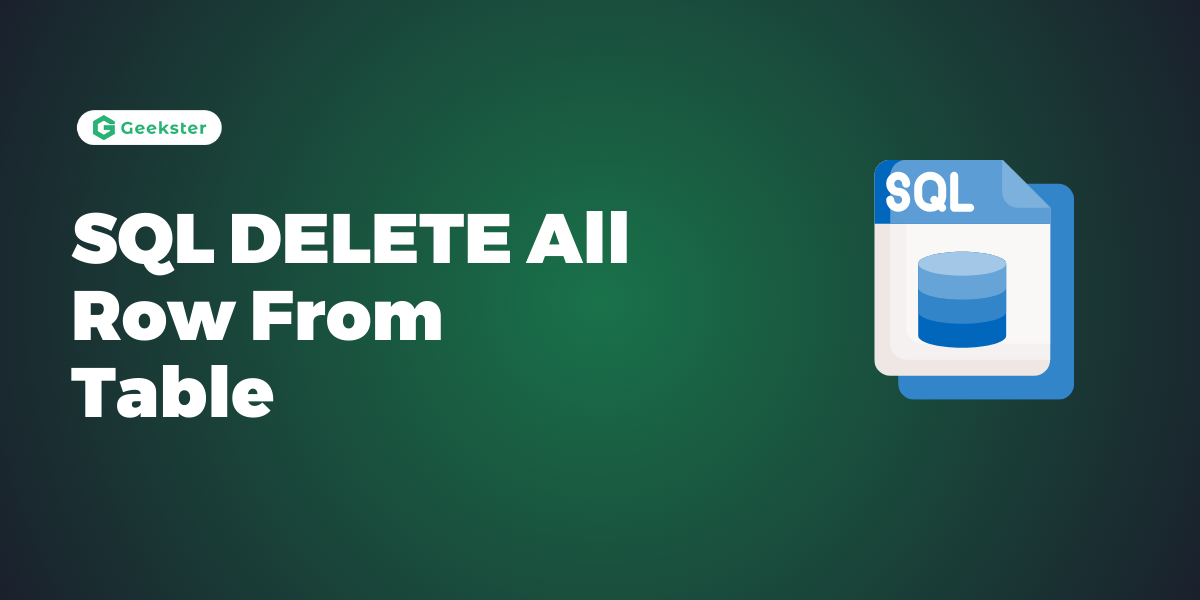SQL DELETE ALL ROWS is a command used to remove all records or rows from a table within a relational database management system (RDBMS). Unlike SQL DELETE ROW, which removes specific records based on specified conditions, SQL DELETE ALL ROWS wipes out all data within a table, leaving the table empty.
This command is particularly useful in scenarios where a fresh start is needed, such as clearing out temporary data or resetting a table to its initial state. However, it’s essential to exercise caution when using SQL DELETE ALL ROWS, as it permanently removes all data without the possibility of recovery.
In this guide, we’ll delve into the syntax and usage of SQL DELETE ALL ROWS, exploring its implications, best practices, and potential pitfalls to ensure safe and effective data management within your database environment.
SQL DELETE ALL ROWS is a SQL command used to remove all records or rows from a table within a relational database management system (RDBMS). Unlike SQL DELETE ROW, which removes specific records based on specified conditions, SQL DELETE ALL ROWS wipes out all data within a table, leaving the table empty. This operation is irreversible and permanently deletes all data contained within the specified table, without the possibility of recovery. It is commonly used when there’s a need to clear out all existing data from a table, such as when resetting a table to its initial state or removing temporary data. However, caution must be exercised when using SQL DELETE ALL ROWS to avoid unintended data loss.
Syntax
DELETE FROM STUDENT_NAME;
Examples of SQL DELETE ALL ROW FROM TABLE
- Example: Deleting all rows from a table
-- Creating a sample table
CREATE TABLE Students (
StudentID INT PRIMARY KEY,
FirstName VARCHAR(50),
LastName VARCHAR(50),
Age INT
);
-- Inserting some data into the table
INSERT INTO Students (StudentID, FirstName, LastName, Age)
VALUES (1, 'John', 'Doe', 20),
(2, 'Jane', 'Smith', 22),
(3, 'Michael', 'Johnson', 21);
-- Displaying the table before deletion
SELECT * FROM Students;
-- Deleting all rows from the table
DELETE FROM Students;
-- Displaying the table after deletion
SELECT * FROM Students;
Output
Before deletion:
| StudentID | FirstName | LastName | Age |
|-----------|-----------|----------|-----|
| 1 | John | Doe | 20 |
| 2 | Jane | Smith | 22 |
| 3 | Michael | Johnson | 21 |
After deletion:
| StudentID | FirstName | LastName | Age |
|-----------|-----------|----------|-----|
- Example: Deleting all rows from a table using TRUNCATE TABLE
-- Creating a sample table
CREATE TABLE Orders (
OrderID INT PRIMARY KEY,
CustomerName VARCHAR(100),
OrderDate DATE
);
-- Inserting some data into the table
INSERT INTO Orders (OrderID, CustomerName, OrderDate)
VALUES (1, 'John Doe', '2024-05-01'),
(2, 'Jane Smith', '2024-05-02');
-- Displaying the table before deletion
SELECT * FROM Orders;
-- Deleting all rows from the table using TRUNCATE TABLE
TRUNCATE TABLE Orders;
-- Displaying the table after deletion
SELECT * FROM Orders;
Output
Before deletion:
| OrderID | CustomerName | OrderDate |
|---------|--------------|------------|
| 1 | John Doe | 2024-05-01 |
| 2 | Jane Smith | 2024-05-02 |
After deletion:
| OrderID | CustomerName | OrderDate |
|---------|--------------|-----------|
- Example: Deleting all rows from a table with foreign key constraints
-- Creating a sample table with a foreign key constraint
CREATE TABLE Orders (
OrderID INT PRIMARY KEY,
CustomerID INT,
OrderDate DATE,
FOREIGN KEY (CustomerID) REFERENCES Customers(CustomerID)
);
-- Deleting all rows from the Orders table
DELETE FROM Orders;
-- Displaying the table after deletion
SELECT * FROM Orders;
Output
Error: Cannot delete or update a parent row: a foreign key constraint fails
- Example: Deleting all rows from a temporary table
-- Creating a temporary table
CREATE TEMPORARY TABLE TempTable (
ID INT,
Name VARCHAR(50)
);
-- Inserting some data into the temporary table
INSERT INTO TempTable (ID, Name)
VALUES (1, 'John'),
(2, 'Jane'),
(3, 'Michael');
-- Displaying the temporary table before deletion
SELECT * FROM TempTable;
-- Deleting all rows from the temporary table
DELETE FROM TempTable;
-- Displaying the temporary table after deletion
SELECT * FROM TempTable;
Output
Before deletion:
| ID | Name |
|----|---------|
| 1 | John |
| 2 | Jane |
| 3 | Michael |
After deletion:
| ID | Name |
|----|------|
Conclusion
In conclusion, the SQL DELETE ALL ROWS statement serves as a powerful tool for removing all records from a table within a relational database management system (RDBMS). This command allows for the swift and complete deletion of data, effectively resetting the table to an empty state.
However, it’s crucial to exercise caution when using SQL DELETE ALL ROWS, as the operation is irreversible and permanently removes all data from the table without the possibility of recovery. Therefore, it’s essential to ensure that the deletion is intentional and aligns with the desired database management objectives.
When employed judiciously, SQL DELETE ALL ROWS can be particularly useful for scenarios such as clearing out temporary data, resetting tables, or performing routine maintenance tasks. By understanding its usage and implications, database administrators can leverage this command to maintain data integrity and optimize database performance effectively.
Frequently Asked Questions
SQL DELETE ALL ROWS is used to remove all records or rows from a table within a relational database management system (RDBMS), effectively resetting the table to an empty state
2.Is SQL DELETE ALL ROWS reversible?
No, SQL DELETE ALL ROWS permanently removes all data from the table without the possibility of recovery. It’s an irreversible operation
3.Can I specify conditions when using SQL DELETE ALL ROWS?
No, SQL DELETE ALL ROWS removes all rows from the table regardless of any conditions. It does not support specifying conditions for deletion.
4.Does SQL DELETE ALL ROWS trigger any constraints or triggers defined on the table?
Yes, SQL DELETE ALL ROWS can trigger constraints such as foreign key constraints and triggers defined on the table, depending on the database system.

